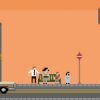After having spent 4 hours with the Japanese demo for OreShika: Tainted Bloodlines for the Vita, I’ve come away feeling it might be one of the strangest RPGs I’ve ever played.
I spent the first 20 minutes crafting a character in my likeness using the robust character creation tools: you can pick facial features such as eyebrows or lips from a pre-selected pool, in addition to changing the size and relative location of the features. After the lengthy process of fashioning an avatar and picking 3 base classes, you finally get into the opening cutscene…where your character, and his entire family, is immediately killed.
And I thought Dark Souls was tough…
The opening cutscene fills in some of the backstory: your family’s town has been ravaged by natural disasters. The townspeople attribute these disasters to the fury of the gods after 5 ritual ornaments in the Imperial Palace have disappeared. As fate would have it your family is chosen for sacrificial appeasement.
Shortly afterwards a god named Kitsuto shows up, and he’s gracious enough to revive you and your family to the best of his ability, but is thwarted by the Curse of Shortened Lifespan, condensing the victim’s life cycle into 2 years and the Curse of Extinction, making it impossible for the victim to have children under normal circumstances. These curses form the basis of OreShika’s game systems.
In short, you control an entire lineage of short-lived warriors to fight demons, grow stronger and pass their strengths onto their descendants. Generation after generation of your family go through a vicious cycle of birth, fighting, and death in an attempt to lift the curse through a lot of dungeon-crawling.
But don’t call OreShika a dungeon-crawler. Its emphasis on fiddling with dozens of sub-systems such as town building, training scheduling, weapon outfitting, loyalty management, and so on feel closer to simulation.
Time management may also play a big role in the full game on higher difficulty levels (the demo was forced to Easy) since many events in OreShika consume a time slot of one month; want to go out for a dungeon crawling excursion? That’s a month. Want to make an exchange with the gods? That’s another month. Want to fully rest up your party? That’s another precious month off your characters’ short lifespan. Time even passes as you stand around in the field or as turns rack up in battle.
At first glance, confrontations in OreShika are trivially easy. Ending an encounter within seconds is simply a case of felling the enemy general, often in one strike, and enemy attacks shave off mere slivers of HP. But the amount of loot varies by the number of sub-demons killed , so you might not want to rush through battles.
But OreShika isn’t about surviving through battle, it’s about keeping your “health” levels topped up. Should your HP fall below 70% your characters’ long-term “health” (as in well-being, not hit points) is impacted, shortening their already meager life expectancy.
After only 20 minutes of intrepid dungeoneering my first month was up, so I chose to head home. Here you can handle family matters; for instance, older, more vulnerable family members can impart their wisdom to younger family members by tutoring them, raising their stats. But leaving family members inactive for too long reduces their loyalty, they may feel undervalued and leave, never to return.
But where do new family members come from when the family’s placed under a curse, preventing them from creating offspring? This is where a type of battle experience called Offering Points (OP), come into play. OP can be spent on asking a god to provide a new family member. The stats of the character and god involved in the ritual determine the base stats and temperament of the child. If you want high stats you might want to save up for the stronger gods that demand larger sums of OP. Just don’t save OP up for too long: if the family line dies out, it’s game over.
I went through with the ritual and sure enough, in time the child appeared on our doorstep. We named the child and assigned them a class type from our 3 base classes. Later on you’ll be able to pick up scrolls that unlock the other class types, expanding party customization options.
There are 8 classes and they vary in terms of how many enemies they can target at once, which enemy row can be attacked from the characters’ position relative to the enemy, and armor type as some classes are unable to use heavy armors.
For armor, there’s so many purchase options and equipment sub-management that I called upon the family attendant Kou, essentially a one-touch auto-equip function, to sort it all out. Kou handles all the tiny details, including managing family finances, setting training schedules, outfitting characters, offering tutorial advice, and keeping a monthly diary on side-quest details and achievements. Though she encourages you to customize everything yourself for best results.
After getting established, the plot thickens. The Imperial Princess stops by to express sincere regret at having set the cull of the family in motion; apparently she too was tricked into believing the sacrifice would appease the gods by a man named Seimei. The game tells you that that Seimei has been seen at local dungeon core. The entrances to the dungeon cores (where the ritual ornaments lie) are only open for a brief one month window during the seasonal demon festival.
Defeating Seimei isn’t easy; get his health below 30% and he heals himself. This is a great situation to make use of the Combine mechanic: I had all party members with the fire skill combine it into one focused attack, doing 8 times the damage of a stand-alone spell. Working together like this builds family loyalty in addition to doing a lot of damage.
The fight ends with Seimei blowing himself up, after which his body regenerates. It’s his way of letting you know that you can never kill him, a big problem given that the curses can’t be lifted until he dies.
It will take the power of the gods to stop Seimei. But even then, the family will have to gather the ritual ornaments necessary to restore the gods to their original luster.
Ore no Shikabane Wo Koete Yuke 2 is out now in Japan for the PS Vita, with the English version, OreShika: Tainted Bloodlines confirmed for localized release sometime later this year. We only had a short amount of time with the game but we’re curious to see the depth of the simulation/management mechanics, since the demo barely scratches the surface. One thing for sure though, there isn’t anything else quite like it on the Vita.









